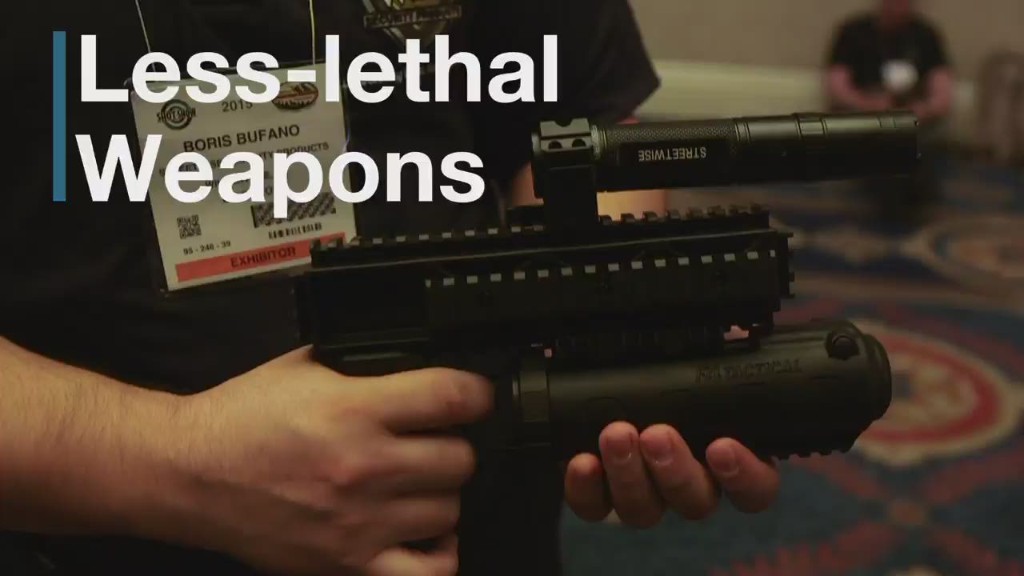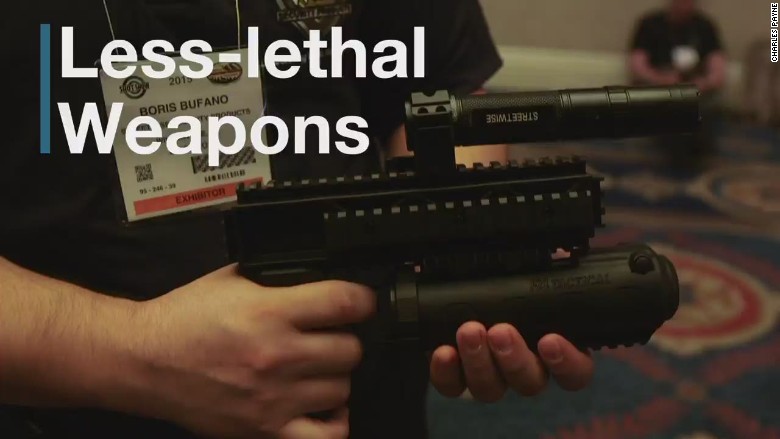
The Police Force Triple Defender is an outlandish new weapon that's designed specifically not to kill you.
Instead, this brand new sci-fi type weapon incapacitates you in three different ways: it can blind you with pepper gas, zap you with a stun gun and then disorient you with a strobe light.
Welcome to the world of non-lethal weapons ... or less-lethal, to use police parlance, because there's no guarantee that they won't kill you.
After all, a common less-lethal weapon that cops use -- the Taser -- has killed people, though the extent of the death toll is disputed. Amnesty International says that more than 500 people have died in the U.S. "after being shocked with a Taser either during their arrest or while in jail." But Taser, the company, says the tally of deaths directly attributed to Taser is more like 60.
Police departments around the nation are under tremendous pressure to find weapons that don't take lives (like the Triple Defender, pictured below). That's because there's been intense scrutiny of incidents where police violence has led to deaths of unarmed people.

Concerns have especially mounted after last year's violence and riots in Ferguson, Missouri, following a white cop killing an unarmed black teenager.
The same introspection has led Ferguson police department to currently explore a device that will diminish the force of a bullet.
Called the Alternative, the device is basically a small metal ball that is clipped on the end of a gun. When the gun is discharged, the bullet embeds itself into the ball as it hurtles towards the target and helps lessen the bullet's impact.
The person probably won't get killed from the gun (pictured below). But it would still hurt like hell.

"It's going to feel like you're getting punched in the chest by Barry Bonds," said Christian Ellis, founder and CEO of Alternative Ballistics, the company that makes the device. "It's going to break some ribs."
Another company, called Security Devices International, offers a variety of less-lethal ammunition than can be fired from 40 mm grenade launchers. This includes projectiles containing pepper gas, or colored liquid to identify suspects. There's also a "malodorant round" which contains "a highly noxious payload that delivers an appalling odor" that can help disperse a crowd.
Related: Ferguson police exploring 'less lethal' weapon option
Ferguson police have also recently been adopting body cameras. The cameras are made by Taser International (TASR). But Tasers themselves have come under scrutiny.
A Taser fires electricity into people and shocks them. On its web site, Taser says its electric pulses "affect the sensory and motor functions of the peripheral nervous system and cause incapacitation." The company claims that weapons do not damage vital organs, have "been safely deployed more than 3.5 million times" and saved 125,000 people from death or injury.
But Amnesty says Tasers unnecessarily kill people.
"We recognize that there is a need for less lethal tools to minimize the risk of death and injury, which is inherent in police use of firearms," said Amnesty researcher Justin Mazzola. "But what we're always calling for is that Tasers be used as a last resort. Right now there are no national guidelines."
Taser spokesman Steve Tuttle said that Amnesty International makes Taser look worse than it is by blaming the weapons for hundreds of deaths that were actually caused by drug intoxication.
Related: Taser stock surged 30% on Ferguson protests
Even the U.S. military is looking into a futuristic weapon for controlling crowds. Developed by Raytheon (RTN), it basically functions like a giant microwave.
It repels crowds by blasting them with invisible heat rays. Raytheon describes its so-called Active Denial System as a weapon that "emits a focused beam of millimeter wave energy that penetrates the skin to 1/64th of an inch, producing an intolerable heating sensation that causes targeted individuals to flee."
Kelley Hughes, a civilian employee working with the military weapon, volunteered to get zapped by it on five occasions. She compared it to the sudden heat from an open oven door, even though she was 3,000 feet from the source of the beam.
"I felt an intolerable heating sensation," she said. "I felt its heat ramping up quickly and lasting a few brief seconds on my entire body. My immediate reflex was to move quickly away from the beam."
The Air Force says the Active Denial System is not a microwave, even if it sounds like one. The Air Force also says it's not radioactive, does not cause cancer or infertility, and can only be lethal if the energy beam is "sustained and prolonged many times."
The Air Force deployed the weapon to Afghanistan in 2010. But aside from testing, it has not been used on humans.
While using such weapons in place of guns might help to reduce casualties, they are also not that widely tested to see what kind of long lasting consequences can result. Also, in many cases, these weapons do end up killing their targets.
They're no substitute for good community policing, according to Sam Bieler, a criminologist and researcher with the Justice Policy Center of the Urban Institute.
"We should really be thinking about what training we can give our police that ... makes them less reliant on force to deescalate tense incidents," he said.

